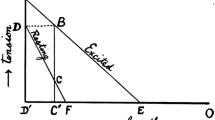Summary
The force-velocity relation during oscillatory work was compared with that measured in the traditional way with quick release and force clamps using toad sartorius, frog sartorius, and mouse soleus muscles. Plotting the force and corresponding velocity data in this way produces a ‘power-loop’. The ‘power-loop’ has less intuitive value than the frequently reported ‘work-loops’ but it is useful because it permits comparison with the force-velocity curve produced using traditional methods. The force/velocity combinations for oscillatory work during a contraction often exceed those that would be predicted from the force-velocity curve. Although it has been known for many years that more force is developed by stimulated muscle when it is being stretched than can be developed during an isometric contraction, my results show that the increase in force is of importance at stretch velocities that probably occur in vivo during locomotion.
Similar content being viewed by others
References
CAVAGNA, G. A. & CITTERIO, G. (1974) Effect of stretching on the elastic characteristics and the contractile component of frog striated muscle. J. Physiol. 239, 1–14.
CECCHI, G., COLOMO, F. & LOMBARDL, V. (1978) Force-velocity relation in normal and nitrate-treated frog single muscle fibres during rise of tension in an isometric tetanus. J. Physiol. 285, 257–73.
GASSER, H. S. & HILL, A. V. (1924) The dynamics of muscular contraction. Proc. R. Soc. Lond. Ser. B 96: 398–437.
JOSEPHSON, R. K. (1985) Mechanical power output from striated muscle during cyclic contraction. J. Exp. Biol. 114, 493–512.
MALAMUD, J. G. & JOSEPHSON, R. K. (1991) Force-velocity relationships of a locust flight muscle at different times during a twitch contraction. J. Exp. Biol. 159, 65–87.
VANLEEUWEN, J. L., LANKEET, M. J. M., AKSTER, H. A. & OSSE, S. W. M. (1990) Function of red axial muscles of carp (Cyprinus carpio): recruitment and normalized power output during swimming in different modes. J. Zool. 220, 123–45.
Author information
Authors and Affiliations
Rights and permissions
About this article
Cite this article
Stevens, E.D. Relation between work and power calculated from force-velocity curves to that done during oscillatory work. J Muscle Res Cell Motil 14, 518–526 (1993). https://doi.org/10.1007/BF00297214
Received:
Revised:
Accepted:
Issue Date:
DOI: https://doi.org/10.1007/BF00297214




